Similarly to the European tradition, also the North American one recognizes in the period of the winter solstice the "gateway" to the world of the dead and of the spirits and, therefore, the suitable time for youth initiations and masked ceremonies, including the Iroquois one of the “False Faces” and the kwakiutl one of the “Cannibal Spirit”. These beliefs and practices, as well as the analysis of shamanic journeys to the "Village of the Spirits", allow us to understand the doctrines of the native peoples of North America on the various souls that make up the human being and on the relationship entertained by the living with the spirit world. .
di Marco Maculotti
cover: historical photo of a kwakiutl winter ceremony
(transcription of some notes taken for the conference "Shamanism, mysteries and sacred people», Held in Turin on 11 May 2019 for the event«Paper Paths to the West: Native American Myths, Legends and Stereotypes», Organized by Soconas Incomindios as part of the OFF Show)
It is well known that in the European tradition the period of the year of the so-called "winter crisis", which runs approximately from the beginning of November (Halloween/ Halloween / Feast of the Dead) in January / February, stands out for a series of beliefs and rituals that have to do with the Other World and initiation. Whether we analyze the Roman Saturnalia, Celtic ceremonies or the Yule of the Norsemen, as well as a series of walking rituals that remained alive in the medieval period to reach us (Romanian Calusari, Austrian Krampus, etc.), the topoi recurring of this period of the year are always the same: temporary regression, pending the beginning of the new year, to one situation of chaos and uncertainty; confusion of social roles; contacts between the world of the dead and that of the living; “visitor's” cult complex; initiation of young people into secret brotherhoods; processions and dances with masks that personify the demons and spirits of the dead, and so on.
Less well known is the fact that i native peoples of North America, whose religious culture is attributable to the sphere of shamanism and animism, contemplate extremely similar ritual beliefs and practices at the same time of the year, which we aim to analyze in this article. We will first deal with the winter initiation ceremonies, and then try to frame the actual initiatory experience and the consequent journey "in spirit" of the neophyte in the "village of spirits". Finally, we will try to define the characteristics ascribed by the North American tradition to the Other World and we will report some esoteric doctrines regarding the survival of the soul (or rather, of souls) to physical death and their consequent access to other dimensions.
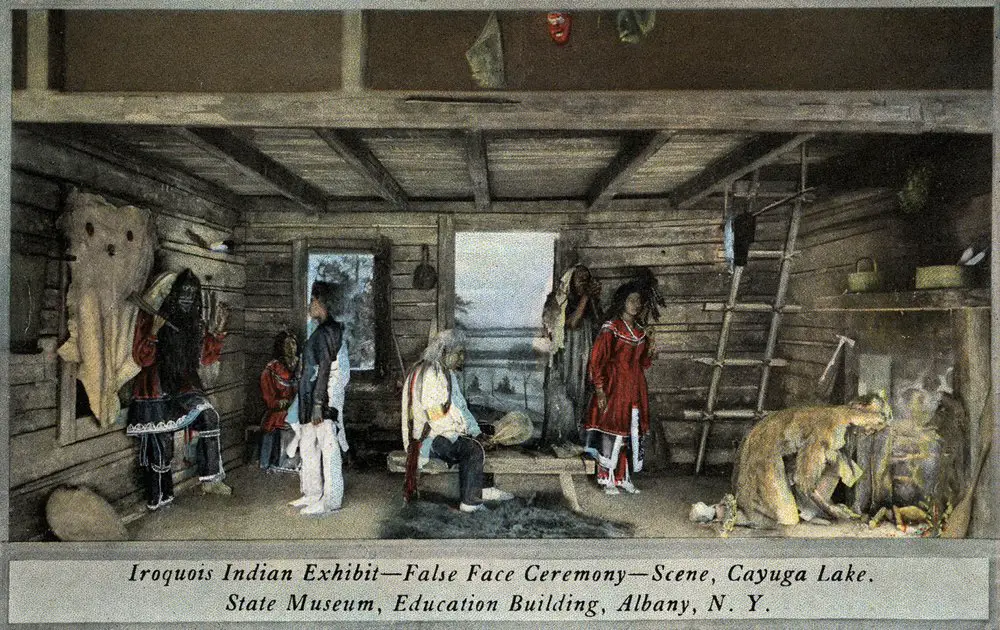
THE MID-WINTER CEREMONY OF THE IROCHESE
The most illuminating ritual tradition of these winter rituals that has come down to us thanks to ethnographic studies is in all probability that of the Iroquois of the subarctic area. In Mid Winter ceremony of the latter, an initiatory lodge known as la False Face Society performs public rituals of exorcism for disease, tornadoes, rushing winds and witchcraft, driving out the negative powers from the village, or therapeutic rites based on the dream experience. The "False Faces" - as opposed to the "Real Faces", that is to say the living - at the same time represent the spirits of the forest and those of ancestors: they are addressed by calling them "grandparents" or "thunder". In fact, it seems that the members of the "False Faces" brotherhood are only imitations of "Sun Faces", spiritual entities that roam deep in the forests, at the extreme edges of the world. The leader of the "False Faces" is said to live at the ends of the earth, that is
"At the extreme edge of the world, in that remote and mysterious area, where the ordinary and supernatural worlds merge and intersect »
As often happens in other geographical and cultural areas, the members of the initiatory society obtain "dominion over the fire" thanks to certain ritual practices: they handle hot coals without burning them and use the ashes of the coals themselves as medicine, rubbing it on the sick patient's body . Another variety of fraternity members wear masks made from dried corn leaves and are referred to "Facce di Paglia": they personify the spirits connected to agriculture and the fertility of the fields (Comba 114-7). The masks of the “False Faces” are instead carved from walnut wood, the sacred tree of Iroquois shamanism (and also the “witch tree” and fairies in the medieval European tradition; Comba 122).
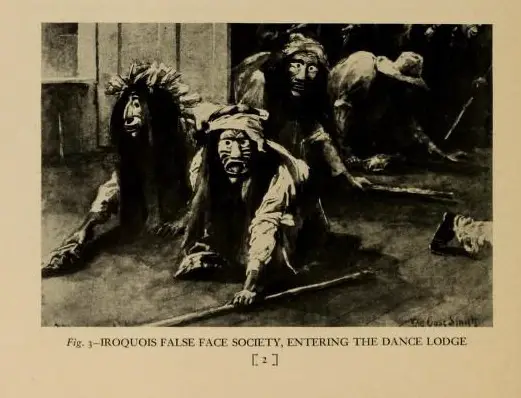
THE KWAKIUTLS AND THE CANNIBAL SPIRIT
Also at the Kwakiutl of the Pacific coast there is a winter ceremony which involves the participation of tribal members of certain masked medicine lodges (the "Society of the Cannibal"), personifying the terrifying and fatal forces that approach the world of the living during the Winter Solstice, when the power of the sun is at its nadir. Among the main characters of this ritual, which also has an initiatory value for the young people of the tribe, there is the dancer who personifies the "Cannibal Spirit" (Hamatsa), from which the members of the initiatory brotherhood were possessed (Comba 479). The dwelling of the god is located on the edge of the world (in the extreme north), that is to say in the farthest conceivable place from the world of men (Comba 486).
The "cannibal" value of the initiating spirit-god is probably to be connected to the topos well known also in other parts of the world (Siberia, South America, Australia, etc.) of "Initiatory dismemberment" by spirits or demons, who then "magically" reconstruct the neophyte's body thus giving him supernatural powers (the same role is played in kwakiutl initiations, as we will see, also by wolves, which must be considered as a "mask" worn by spirits to interact with humans). In this ceremony the so-called is also erected "Palo del Cannibale", obtained from a young cedar tree, mirror image of the young neophyte who has to go through a process of transformation (Comba 489).
The rituals that allow access to our world, during this limited period of time of the "winter crisis", of the spirits of the other world are many and different according to the different Amerindian tribes. At the Cree of the subarctic, for example, the latter they are recalled inside the tepee through the upper opening; their arrival causes the tent to shake (for this we speak of "Ritual of the Trembling Tent") and all those present can distinctly hear whispers and deafening noises, a sign that the supernatural powers have been recalled in the manner prescribed by tradition and that they are now present among the bystanders, to give them advice and visions. During the "Feast of the Bladder", also held around the winter solstice, the spirits of the seals, who were believed to reside in their veschiche, in the houses of the village, were invited to ensure their periodic return the following season (Fienup-Riordan 128).
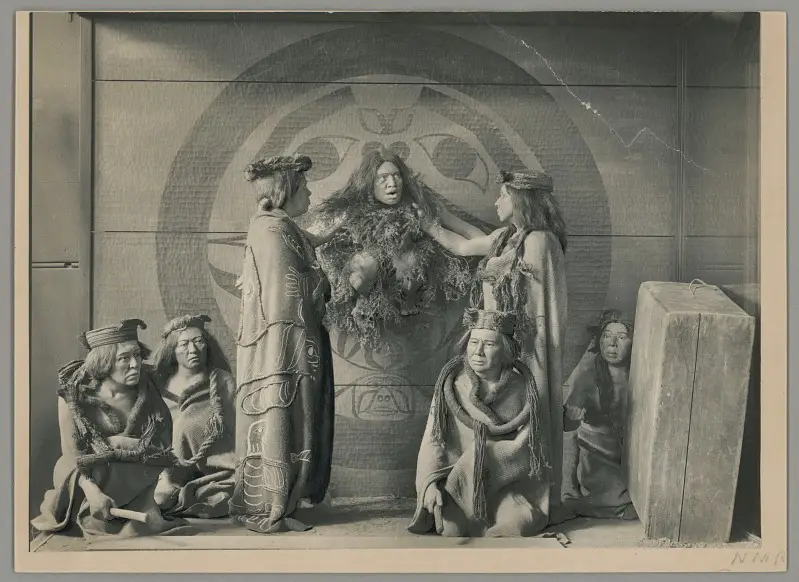
THE INITIATIVE EXPERIENCE
However, the temporary coming into the world of men of these spirits is not univocal: in a specular way, in this period of the year the living are initiated into mystery practices and, consequently, they are able in turn to access the Other World, or the world of the dead and spirits. In fact, it is believed that during initiation and the consequent astral "journey", the shamans come in another dimension, which is presented as dark and abyssal, a sort of "cosmic womb" from which the power of Manitu and his innumerable messengers emanates as from a primeval source. A sacred song of the Northwestern Kwakiutl says (Comba 472):
“I was carried away, far inland, to the edge of the world by the magical power of heaven, the treasure. "
During the initiation ceremony ojibwa, members of the Society of Medicine They "hit" the neophytes by projecting a shell into their body, which is magically "thrown" by means of the "medicine bag". The initiate falls as dead, then is brought back to life by the brotherhood: now he is in possession of new powers and knowledge and is in effect considered "reborn"(Comba 157). Between Kwakiutl they are gods quartz crystals to be projected into the neophyte's body by the spirits (often in the form of a wolf) to give him supernatural powers: the same belief is sensationally found at the opposite end of the Pacific Ocean, in Australia.
The shamans, in the trance phase, visit worlds other than ours: in spirit they go to the supernatural skies or to the inferior worlds, where they meet and dialogue with the spirits, recover the lost soul of the patient and objects lost by the tribal members. Some descriptions of shamanic journeys are in all identical to those of the Siberian tradition: in a tale of the Paiute of the Rocky Mountains, for example, it is implied that the soul leaves the body in the form of a "small insect" and that he is about to leave the tent, symbol of the body, coming out of the smoke opening on the roof (which is also in the gher or Mongolian-Siberian yurt), symbol of the upper wall of the skull (Comba 450). Come back often the idea that "power" is somehow a "spiritual double" of the physical person (perhaps similar to the daimon Greek gods), dwelling in a dark and abysmal dimension connected to the dream, which the shaman can rejoin during his ecstatic "flights" (Comba 452).

THE INITIATION BY THE ZOOMORPHIC SPIRITS
Among some tribes of the Rocky Mountains the spirits appeared in anthropomorphic and zoomorphic form to children aged 8-10; the experience was forgotten for about 15 years, after which the subject fell prostrate in a state of disease and starvation. At this point it was necessary to entrust it to a medicine-man who, with the necessary rituals, would initiate him and allow him to firmly gain shamanic powers (Comba 388-93).
In the subarctic area there are testimonies and stories of shamans educated and initiated by packs of wild animals, such as wolves, bears and partridges (Comba, 263), who have the same role and the same function recognized to spirits in Austro-Asian, Altaic-Siberian and Turkish-Mongolian shamanism. These kidnappings for initiatory purposes also generally took place in the winter, in the days of Mid Winter ceremony.
Among the Kwakiutl the neophyte is approached and kidnapped by the helping spirits, who often appear in animal guise (wolves, sea killer whales, loons). Initiation involves a period of confinement in the forest (and, conversely, in the "dark" dimension of the spirits), in which he is detained, instructed and endowed with supernatural powers by the initiating spirits (Comba 463). Newbies were thought to come possessed by the mysterious and terrifying power which emanated supernatural beings, temporarily transforming them into wild beings with fearsome and disturbing characteristics (Comba 479).
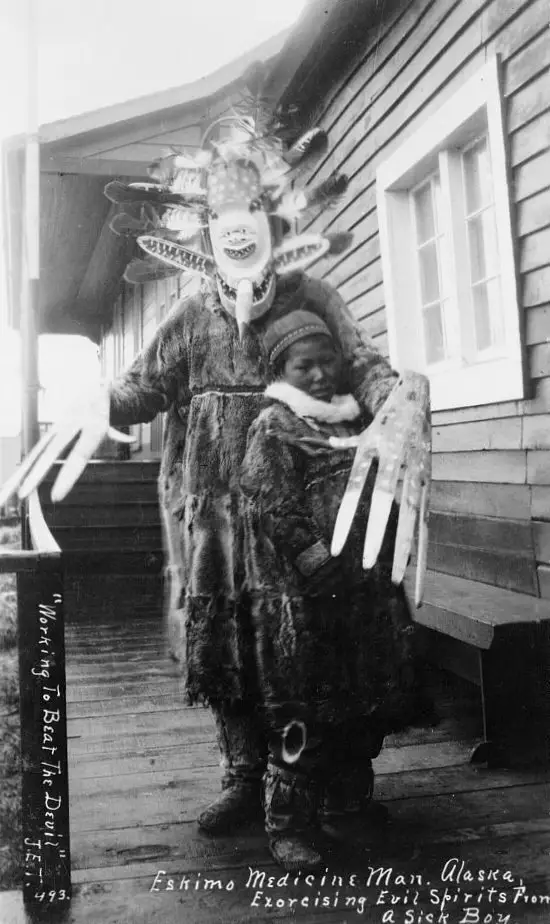
THE ZOOMORPHIC SPIRITS AND THE OTHER WORLD
Among the Eskimos Yup'ik there are tales of humans who would have gone to live in the underwater home of seals; but the latter turn out to be not real animals, but "people" of different sizes: according to the tradition of the native peoples of Alaska, contemporary animal species are descendants of past humanity, transformed following a conscious infringement of the ritual prescriptions (Fienup-Riordan 118-9).
- hopi speak of a "Snake Village", located near the underground abode of the spirits of the dead, where a member of their tribe would come; here he married a snake-bride, who as in the European legends on the "Fairy bride" (eg. Melusina) she joined him and bore him a son, but making a taboo as a condition. Just as in medieval European tradition, once this taboo is violated (eg, the man spies on the woman taking a bath), the snake-bride immediately leaves her husband and takes her son away. According to legend, the very famous snake dance of the Hopi - studied among others by Amy Warburg - was established precisely after this union: the dancers would impersonate the descendants of the child born from the union of their mythical ancestor with the snake-wife (Erdoes / Ortiz 584-7).
At the Kwakiutl salmon are also particularly sacred: it is said that the shamans and the twins are reincarnated salmon. In this we can perhaps glimpse a parallelism with the Celtic tradition, where salmon symbolized wisdom. (According to the Lakotas, twins and sacred people are reincarnated very easily and are born already in possession of intellectual maturity; Powers 83). It is believed that at night the soul of the shamans leave the body and travel with the souls of the "salmon" (which however appear in all respects as human - or superhuman) beings until reaching the village of Mäêsila, at the extreme limit of the world, where all the souls of men reach (in ecstatic states and after death).
These mythical entities have characteristics in common with the spirits of the dead, but even more so with the fairies of the European tradition: it is said that their souls are always around, around us, but that we cannot see them. It is also believed that the soul of man during the day is small, but when night falls and we fall asleep it becomes large and can travel far (Comba 513-5).

TRIPS TO THE "VILLAGE OF THE SPIRITS"
The world of the dead (often referred to as "Village of spirits") appears as a exact duplication of the human one, but in reverse (Menicocci1 186): umpteenth variation of topos well known also in the European context ofOther World as a "world upside down". Sometimes the afterlife is described as A big garden, in which it is always day (Comba 234). In many stories the "Land of the Spirits" seems a perfect counterpart of the "Land of the Fairies" Europeanfairy land o elfin): in it a multitude of people dance and play, disappearing together with the whole vision with the first rays of the sun. Other topoi dear to the European tradition, they can be found in the stories focused on the journey into the underworld, including the recommendation of never eat offered food from the entities of the "world below" nor of turn around back during the ascent to ours (Comba 431).
Some near-death experiences recorded by the ojibwa tradition describe the world of the dead, located at the end of the "Path of the Spirits", in a similar way to the Celtic tradition: the protagonist of these experiences meets the spirits of deceased tribal members, who inquire about the health of their relatives and descendants and offer the newcomer of the food which he must not accept if he does not want to remain in that world forever (Comba 230; identical topos in the European and Asian tradition). To some people who had been dead for a very long time, it grew moss on the skin: perhaps a clue to the conceptual closeness, in archaic traditions, between spirits of the dead and spirits of vegetation and crops (Comba 231).
The texts of the Winnebago which narrate experiences after death recall the otherworldly paths of the Tibetan and Egyptian Book of the Dead (Comba 144). We speak of a "Song track" to follow that would lead the soul of the deceased to the place where the ancestors and the dead were, in the far south (Comba 239). The Ojibwa they believe that there is a "place of punishment" halfway from the "Land of Spirits", whence a fire is released which burns all that is evil in the souls of the dead (Comba 164).
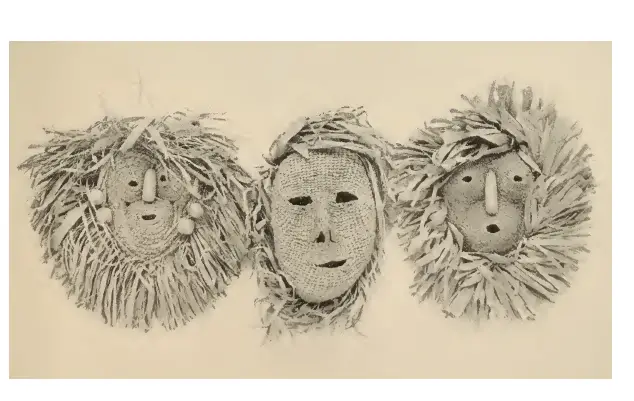
SOUL AND REINCARNATION
Generally speaking of the world of the dead in a positive, not fearful or terrifying way (except for some Pueblo tribes such as the Navajo): an Ojibwa says that it is not right to cry too much for the dead, as they are in a beautiful place where "They are doing well" (Comba 231). When a Crow tribal member claims to be dead, to have visited the afterlife, and to have come back, he usually develops a strong nostalgia for the world of the dead, to the point of definitively dying shortly after (Menicocci1 185).
In other stories, for example. of the Kwakiutl, it is said instead that the souls of the dead do not want to stay there, and "come back to life continuously even after having been dead for a long time" (reincarnation). It is stated that in this other world the spirits are exactly like us, just as if they were alive (Comba 526). When a tribal member dies, all objects owned by him are burned so that they can be rebuilt in the other world (Comba 527).
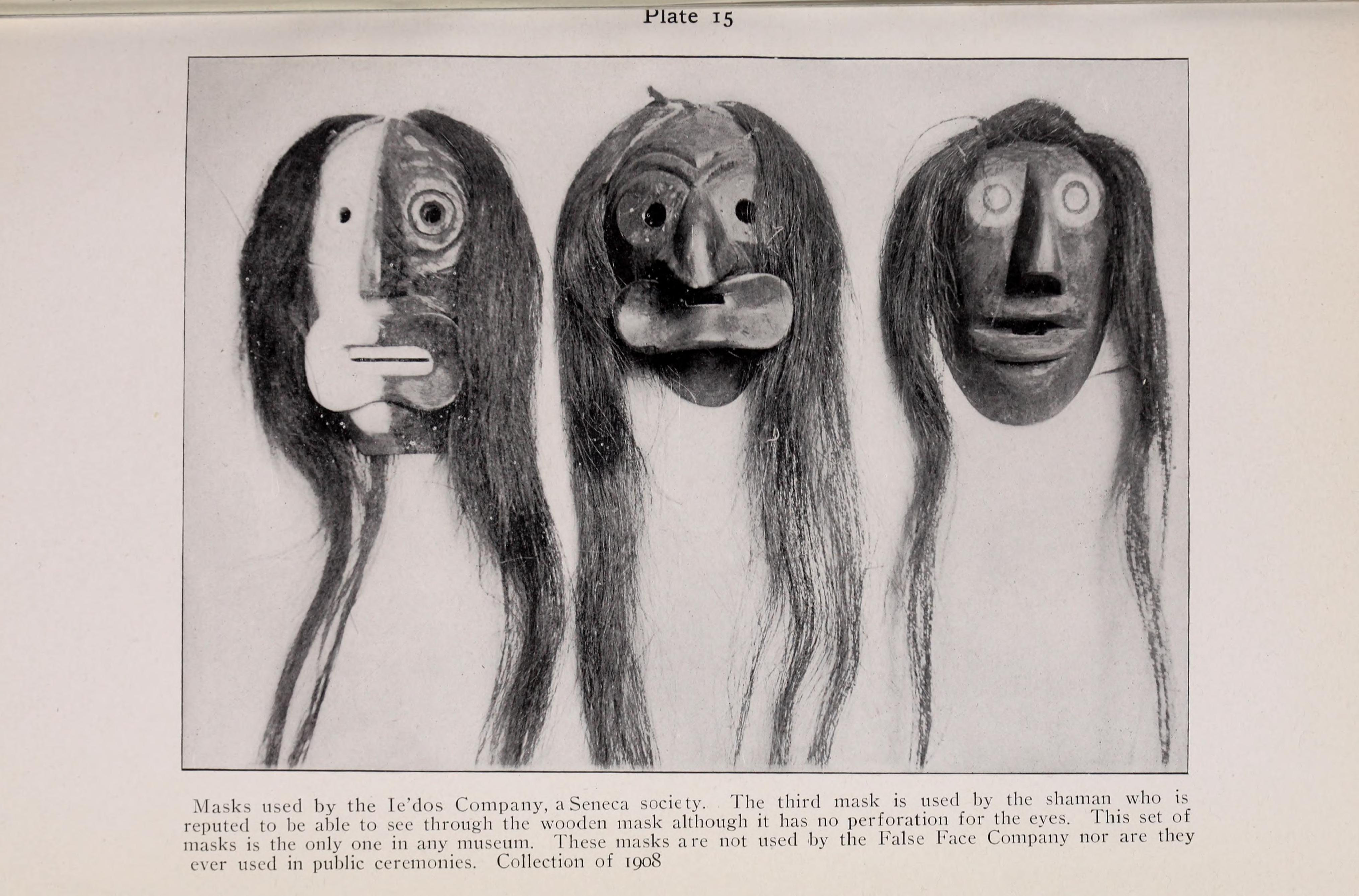
Often, for example. among the Crow, the disembodied spirits residing in the other dimension are imagined in one a condition of perennial peace and happiness, which recalls the life of the natives before the arrival of the white man. The visit to the world of the dead thus becomes, for those who experience it, comparable to a desirable escape from the world on a personal level in the face of the current unacceptable situation: a theme in some respects "millennial"(Menicocci1 186-7).
I Crow use a term to define the life force that remains after death, with a meaning similar to "soul"(Zoe) of Westerners; this term, etymologically connected with those that translate "shadow","ghost, ghost”And“ devil or malevolent spirit ”, can also refer to the Life force animals and inanimate objects (eg. “sacred stones”, Menicocci1 189). It is believed that the spirit of a deceased can take possession of the body of a living being, and return to our world in the form of wind swirls (Cfr. fairies in the European tradition). Sometimes the spirits of the dead are summoned by the shaman with a ritual in his own tent: in this case they manifest themselves with whispers, whispers, whirls of air and lullabies (Menicocci1 190); it is, as has been said, the so-called ceremony of the "Trembling Tent" widespread mainly in the subarctic area.

THE "HOUSES OF CHILDREN" AND THE DIFFERENT SOULS
Even the Amerindian doctrine of reincarnation has strong correspondences with the European tradition of gods fairies, which are often related to the souls of the dead. THE they send believed that, before reincarnating again, the soul of the deceased lived together with many others in three hills called "Children's Houses", which closely resemble the hills and “fairy” mounds of the Gaelic-British tradition. It was believed that in these "homes" a deceased elder would take care of the souls who, at a given moment, would choose a mother to be reborn in our world. Not surprisingly, exactly as in the Gaelic tradition, childless women went to these hills to beg their little guests to choose them as mothers.
It was also believed that children who died a few days after their birth without receiving their first name would return to the “Children's Homes”, from which they would then be reincarnated again (Menicocci2 45-6). There are therefore, in the conception of the Mandan and other native tribal groups, gods "Deposits" or "reserves" of souls which potentially belong to the social group of living beings and who only await the right moment to reincarnate within the clan, in our sublunar reality plane (Menicocci2 47).
The Mandans, like other native Amerindian groups, on the other hand, contemplated the existence of several souls, which at the moment of death would have taken different "paths". In fact, if one, as we have seen, returned to the "Children's Houses" waiting to be reincarnated again, a second soul at the moment of his passing he went to heaven, from the "Great Spirit"; a third reached the realm of the dead proper, located in the extreme south of the world; finally a fourth remained potentially linked to the terrestrial plane and could be a cause of danger (Menicocci2 48), which is why it was sometimes necessary to perform certain rituals to limit the damage caused by the unwanted "presence".
Sources:
- COMBA, Henry: Rites and mysteries of the American Indians, UTET, Turin 2001
- ERDOEZ, Richard & ORTIZ, Alfonso (edited by): Myths and legends of the American Indians, Mondadori, Milan 1994
- FIENUP-RIORDAN, Ann: “The Eye of Dance: Spiritual Life of the Central Yup'ik Eskimos,” in SULLIVAN, Lawrence E. (ed.): Cultures and religions of American Indians, Jaca Book, Milan 2000
- MENICOCCI, Marco (Menicocci1): Grasslands without "Beyond". Death and “beyond the world” fate among the Crow Indians, on Academia.edu
- MENICOCCI, Marco (Menicocci2): Reincarnation without immortality. Death and otherworldly fate among the Mandans, on Academia.edu
- POWERS, William K .: Drying the Tears: Lakota Religion Towards the Twentieth Century, in SULLIVAN, Lawrence E. (editor): Cultures and religions of American Indians, Jaca Book, Milan 2000
- WARBURG, Amy: The Serpent Ritual, Adelphi, Milan 1998

8 comments on “Shamanic initiation and the ways of the afterlife in the North American tradition"